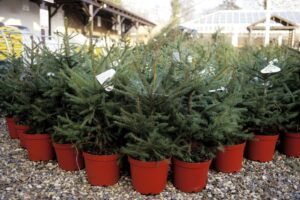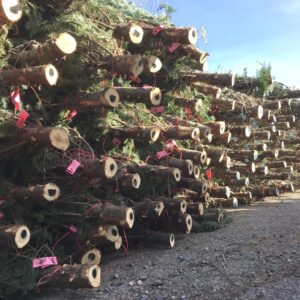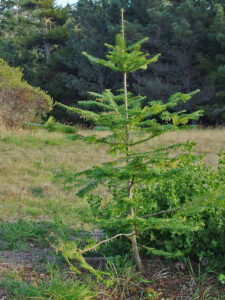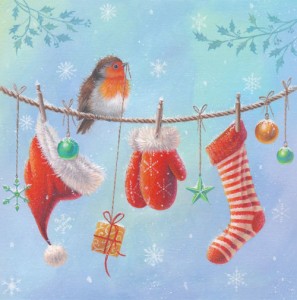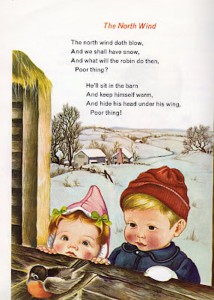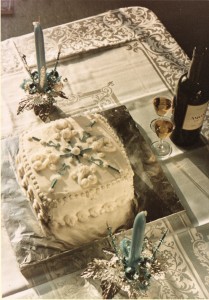Posts Tagged ‘Christmas’
Death of a Christmas Tree
We’d bought the young spruce in a fit of environmental consciousness when we still lived in Cupertino, CA. and it served as our Christmas tree for several years. In 1973 it survived our move to Santa Barbara, carefully bolstered in the U-Haul truck so it wouldn’t get smushed. It put up with a year or so of Santa Barbara sunshine, had even come into the house one holiday season. But that year, 1975, the temperature spiked into the 80s just after Christmas and hot sun streamed into the house. I was too busy with holiday guests and activities to think about moving the tree outside into the shade, so it stayed inside far too long. By the time we disburdened it of its decorations and lugged it back outside, the damage was already done. Months later, when I could no longer bear to look at pathetic brown needles, I removed it from its pot. The roots were tightly bound around each other.
One received wisdom is that you buy a potted tree for the holidays, then plant it in your garden. But this is not realistic if the tree’s grown size will overpower existing plantings, or if its natural habitat is elsewhere. I found a curious example of this when a few decades later we moved to Mendocino. In the patch of native forest on our property I found two trees with silvery needles. A naturalist friend identified them as some kind of spruce, definitely not native. She told me the story of how they most likely got there. The original developer had been hauled into court for illegally logging the property to create a “view development” and was ordered to replant. She speculated that he picked up a job lot of leftover Christmas trees to fulfill this requirement. Our two spruces, crowded out by redwood and Douglas fir, did not survive much longer.
So what to do about a Christmas tree? Over the years we’ve tried various approaches. We’ve gone to cut-your-own tree farms. But sawing into a young tree felt like committing murder. We’ve bought a cut tree from a lot and kept it outside in a tub of water for as long as possible. Even so, it would be shedding needles even before it came into the house. It would have been been cut weeks before, and shipped hundreds of miles from where it was grown. We’ve thinned out young firs from our own property. But they’ve been spindly little things, too likely to topple.
For the past couple of years, we’ve not bothered with a tree at all. I’ll maybe clip some low-hanging conifer branches to make a big arrangement in a bowl on the dresser or a wreath for the door. But that’s about it. I like my trees living. Like this baby Grand Fir that workers clearing a drainage channel a few weeks ago rescued from an overgrown coyote bush and saved for me.
Robin redbreast on a fence
I still ponder why it meant so much, that Christmas morning in England in the 1960s, that a robin sat on the back fence. The field behind the fence was white, the fence wires thick with hoar frost, and the little red-breasted bird made the scene perfect. Finally, I told myself, a ‘real’ Christmas.
I have tried for many years to clarify my feelings about the disconnect between the traditional trappings of the season and my experience of growing up in New Zealand, where the seasons are reversed. My childhood Christmas memories are of summer: the tree laden with oranges in my grandmother’s garden where we hung our presents and picnicked on the lawn; the scent of magnolia blossom outside the church on Christmas Eve.
Also the Christmas cards with their images of snow (which I’d never experienced) and yes, the English robin. I knew about robin redbreast from the old nursery rhyme, but until that Christmas I hadn’t seen one.
Now on the coast of Northern California, I have a different understanding of how to celebrate the winter season. Our multicultural society recognizes many winter festival stories and traditions: the birth of Jesus in a stable, the menorah candles of Hannukah, the Swedish light-bringer St. Lucia, the gift-bringer St. Nicholas (known also as Santa Claus), and many others. The celebration that holds the deepest meaning for me now is Winter Solstice, the return of the light. From summer to winter, I note where on the horizon the sun sets, and how the darkness grows. Even as clouds gather, the place where sun disappears into ocean fogbank moves steadily to the south. When the prevailing westerly wind shifts to the southeast, I know to expect the winter rains. Sometimes a shower or two, sometimes, such as this past week, a prolonged deluge that floods rivers, downs power lines, and closes roads.
Meanwhile, the earliest spring flowers are breaking bud, and over-wintering birds gather hungrily at my feeder: Steller’s jay, spotted towhee, hermit thrush, acorn woodpecker, hordes of white-crowned sparrows. I love them dearly. I am happy that I have learned to understand the connection between the flow of seasons and human efforts to explain them with stories and festivals. And I still have a place in my heart for the memory of that cheery robin redbreast who brightened an English winter.
A season for love (and cake)
What I loved about living in England as a young woman in the 1960s was the traditions around the holiday season. On foggy street corners in London, vendors with portable braziers sold roasted chestnuts, hot in the hand, but so good. Butchers’ shop windows would fill with huge hams, neighbors’ kitchens be redolent with the aroma of figgy puddings steaming on stove tops. I would pull down the English recipe book my mother-in-law had given me and assemble ingredients for my Christmas cake: an assortment of dried and candied fruit, spices, juice, eggs, butter, brown sugar, treacle, flour, and the all-important dash of rum.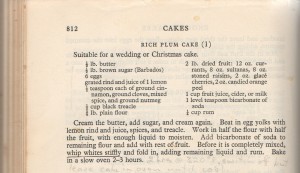
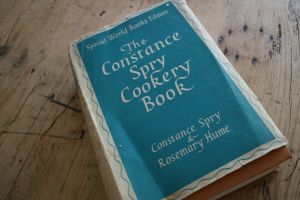
Cookbook cover, considerably more pristine than my beat-up copy. Image from http://magazine.direct2florist.com
Making a proper English fruitcake is a multi-day affair. First, the careful preparation of the tin and timing of the baking so that it doesn’t go dry. My Constance Spry Cookery Book devotes several pages to these matters. Then the making of the cake itself. Several days later, in preparation for icing, the cake is brushed with a warm apricot glaze. My cookbook declares:
The object of this protective coating is to avoid any crumb getting into the icing and also to prevent the cake absorbing moisture from the icing and so rendering it dull.
Next comes the layer of almond paste or marzipan, rolled out like pastry and smoothed on with the palm of the hand. A day or three later comes the smooth base coat of royal icing, made by mixing egg whites and lemon juice with the sugar. When this layer is perfectly stiff and hard the decoration is piped on.
When we moved to California, I continued to make Christmas cake for a few years, until I realized that fruitcake in America is the butt of seasonal jokes and that my lovingly prepared cake sat in the pantry scarcely touched. I am grateful that until his death a few years ago, my late brother-in-law Derek Heckler, who lived not far away, continued to bake and share a splendid traditional cake.
As earth and sun roll toward another pausing time, let us remember dear friends and family members now gone, and reach out in love to those still with us. However you celebrate the season, may it be filled with the traditions you hold dear.
Midrash
This year, Tony and I hosted a winter solstice gathering. Rain pelted down, darkness closed in. But a good fire blazed on our hearth, and a pan of Yul Glogg simmered on the stove. Friends hung wet coats on the rack in the entry hall and offered gifts: a jar of preserves, a bag of cookies, a candle. One brought a poem to read, another a copy of an article she thought I might enjoy. We visited, we ate and drank.
Around the time when the sun, if we could see it, would be dropping into the sea, Tony said a few words. We listened to the poem, Rebecca Parker’s “Winter Solstice.” A hush surrounded her words:
“…earth hangs poised
in the crystalline darkness, and then
gracefully
tilts.
Let there be a season
when holiness is heard, and
the splendor of living is revealed.”
(The whole poem can be found on the Nancy Drew Too blog).
After our guests were gone, I read the article I had been given. It was from the December 2010 Friends Journal. I loved the title, “A Quaker Midrash.” The author, Charles David Kleymeyer, explains that the Jewish term “midrash” is an imaginative reconstruction of missing parts of a sacred text. He creates a narrative to account for the twelve days between the birth of Jesus and the arrival of the Magi; how it was that Mary and Joseph were able to stay in Bethlehem long enough to meet them.
As I sat with the two texts in front of me, the article and the poem, I realized that all our sacred texts are midrashim. Faced with immensity, we humans make stories to explain our overwhelm of reverence. It no longer matters that Christianity appropriated the calendar dates and customs of the Roman Saturnalia, or that the Twelve Days of Christmas derive from the timeframe of the old Norse festival of Yule. It’s immaterial whether we celebrate the birthday of the sun or of the Son. What matters is the pause, as of the sun in its path at the solstice, to remember who we are and why we are here.
